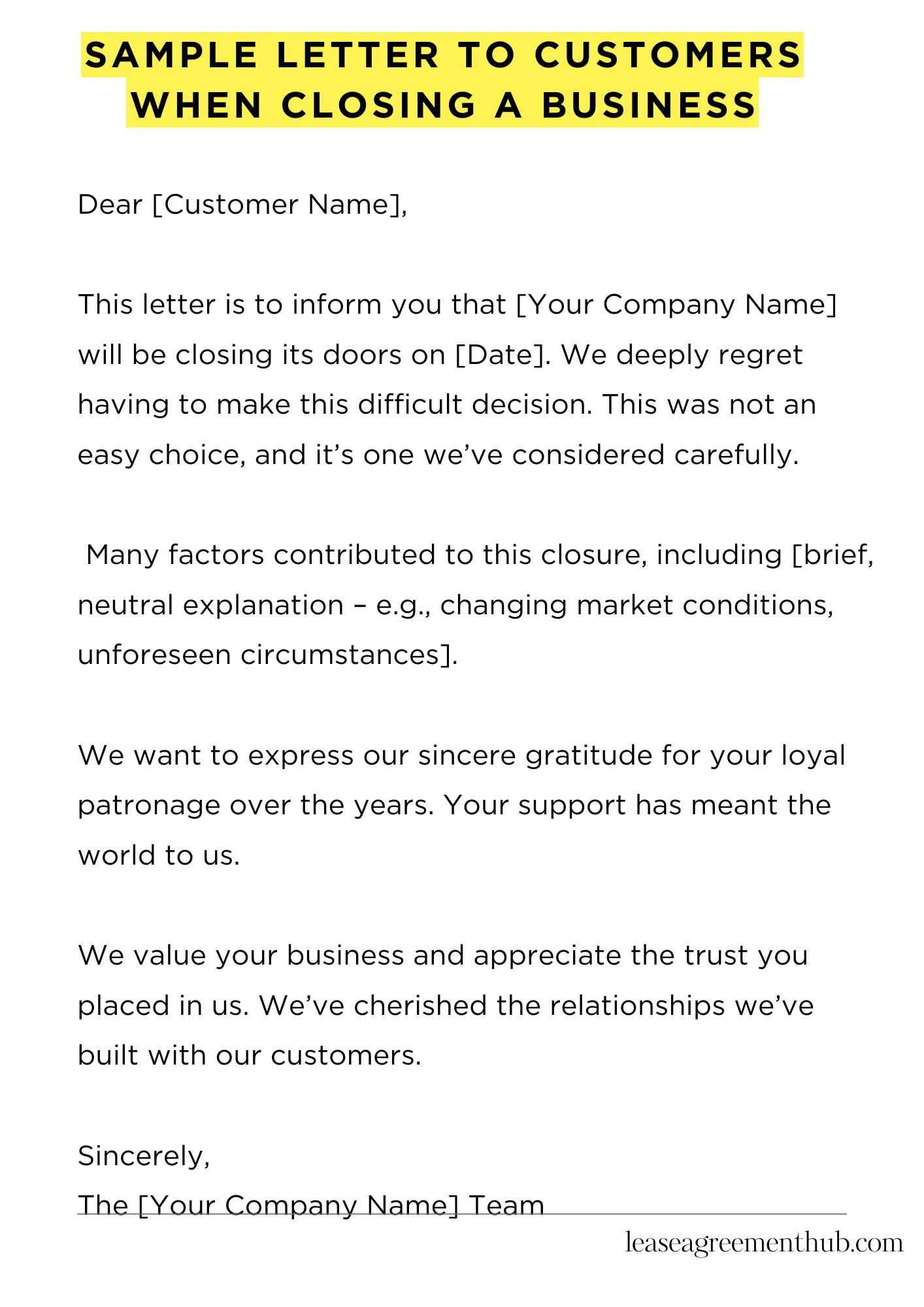Closing your business? You need to tell your customers. This letter does that. It’s a professional goodbye.
This article gives you examples. Use these samples as templates. They make writing your own letter easy.
We’ll show you different options. Choose the best fit for your business. Say goodbye the right way.
Sample Letter to Customers When Closing a Business
[Your Company Letterhead]
[Date]
[Customer Name]
[Customer Address]
Dear [Customer Name],
This letter is to inform you that [Your Company Name] will be closing its doors on [Date]. We deeply regret having to make this difficult decision. This was not an easy choice, and it’s one we’ve considered carefully. Many factors contributed to this closure, including [brief, neutral explanation – e.g., changing market conditions, unforeseen circumstances].
We want to express our sincere gratitude for your loyal patronage over the years. Your support has meant the world to us. We value your business and appreciate the trust you placed in us. We’ve cherished the relationships we’ve built with our customers. Thank you for being a part of our journey.
We understand this news may be inconvenient. To help ease the transition, [explain any actions being taken to assist customers – e.g., information about outstanding orders, details on refunds or alternative suppliers]. You can find more information on our website at [website address].
We wish you all the best in the future. Thank you again for your support.
Sincerely,
The [Your Company Name] Team

How to Write a Sample Letter to Customers When Closing a Business
Understanding the Gravity of the Situation
Closing your business is a momentous decision, fraught with complexities. It’s not merely a transactional event; it’s a parting of ways with your clientele, a severing of established relationships. Therefore, the communication surrounding this closure must be handled with the utmost care and professionalism. A poorly worded announcement can irreparably damage your reputation. Consider this letter your final impression.
Crafting a Compelling Salutation
Avoid generic greetings. Instead, opt for a personalized approach. If you have a database of customer names, utilize it. Addressing individuals by name demonstrates respect and fosters a sense of connection, even in this valedictory communication. A simple “Dear Valued Customer” lacks the personalized touch that distinguishes a professional letter from a mass-produced announcement.
Conveying the News with Clarity and Empathy
Directness is paramount. Avoid obfuscation or circumlocution. State unequivocally that your business is closing, providing a definitive closure date. However, inject empathy into your message. Acknowledge the potential disruption this decision may cause your customers. Phrase your explanation with sensitivity, acknowledging their loyalty and patronage.
Detailing Next Steps and Providing Alternatives (If Applicable)
Don’t leave your customers hanging. Outline the practical steps they need to take. Will outstanding orders be fulfilled? What about refunds or exchanges? If possible, and appropriate, suggest alternative businesses that might offer similar products or services. This mitigates potential negative feelings while demonstrating your commitment to their needs, even in your business’s final act.
Expressing Gratitude and Acknowledging Loyalty
This is your opportunity to express sincere gratitude for your customers’ support over the years. Their patronage has enabled your business to flourish. Acknowledge their loyalty and highlight specific positive aspects of your interactions. A heartfelt expression of thanks can leave a lasting positive impression, even in the face of closure.
Concluding with Professionalism and Contact Information
End the letter with a professional closing. “Sincerely,” or “Respectfully,” are appropriate choices. Provide contact information for any outstanding issues or queries. This demonstrates your continued commitment to customer service, even as you transition away from active business operations. Consider including a website or email address for continued communication.
Review and Refine Before Distribution
Before disseminating your letter, meticulously review it for grammatical errors and typos. Ensure the tone is consistent and professional throughout. A second pair of eyes can provide invaluable feedback. A proofread letter exudes professionalism and showcases your attention to detail, leaving a positive final impression on your valued customers. This final act of diligence is crucial for preserving your reputation.
FAQs about sample letter to customers when closing a business
What information should I include in a letter announcing my business closure?
Your letter should clearly state the closure date, express gratitude to your customers for their patronage, explain the reason for closing (if comfortable sharing), and provide information on how customers can access any remaining services or products, such as refunds, warranties, or contact information for related businesses.
How far in advance should I notify my customers about the closure?
Ideally, you should provide at least 30 days’ notice, allowing customers ample time to make alternative arrangements. The specific timeframe may depend on your industry and the nature of your business relationships.
What is the best tone to use in a business closure letter?
Maintain a professional, sincere, and appreciative tone. While explaining the closure, avoid negativity or blaming others. Focus on thanking customers for their support and expressing regret for any inconvenience.
Should I offer any incentives or discounts in my closure letter?
Offering discounts or incentives on remaining inventory or services can be a thoughtful gesture to show appreciation and encourage final purchases. However, this isn’t mandatory and depends on your business circumstances.
Where should I send the closure notification letter?
Send the letter to your customers via their preferred method of contact, such as email, postal mail, or through your website. If you have a large customer base, consider using multiple channels for wider reach.
Related: